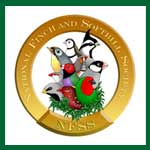Bengalese
18th June 2012
Welcome to Northwest Bengalese Finches..
An Informative Site About Society Finches, Their Colors, and Care
The Society Finch (North America) or Bengalese Finch (elsewhere), Lonchura striata domestica or L. domestica, is a popular cage bird not found in the wild. It is a member of the estrildid finch family. Many authorities call it a domestic form of the White-rumped Munia (known in aviculture as the Striated Finch), at least probably, though some state that it originated as a hybrid of this species with others in the genus DNA study found that it was more closely related to the White-rumped Munia than either bird is to the Zebra Finch, the Chestnut-breasted Munia, or the “Silver Bill” (presumably the Indian Silverbill), indicating that it originated from the White-rumped. Bengalese Finches are well adapted to captivity and the company of humans. They breed well and are good foster parents for other finch-like birds.
These birds like to be close together and tend to all roost in one nest if kept in a group. In an aviary they lay eggs and crowd into a single nest, interfering with incubation, which is performed by the female and lasts 16 days, or damaging the eggs. Thus they breed better if kept as single pairs in individual breeding cages. This sociability is also responsible for their American name of “Society Finch”. They are cheerful little birds that are quite easy to look after. They are also quite easy to breed provided they are, of course, adequately sexed.
Obtaining a female-male pair can present a difficulty because both sexes look exactly the same at first glance. However, it is possible to determine gender by behavior since males tend to display to impress and court females. The best way of using this method to sex Bengalese is to place a single bird in a small cage and completely isolate it from its own kind for several hours; then introduce another Bengalese to the cage. If the first bird is a male it will immediately display to the newcomer. Unfortunately this does not necessarily mean the introduced bird is a female. But if the first bird does not display it is almost certainly a hen.
However, a quicker and more sure method of sexing is to compare both the head width, in a line across the top of the head between the eyes, and the shape of the under-side of the beak. The male has a much broader head than the female; and the male’s under-beak, where the beak meets the feathers of the neck is a “V’ shape and the hen’s more rounded like the bottom of the letter “U”. In both these methods the two birds should be held side by side to compare.
They are generally given a diet of seeds, such as millets and canary seed, and greens. They will not usually take live-foods, but it has been found they will often accept house fly pupae, which they crack like seed. This is particularly useful if they are being used to foster species that require a high protein component to be successfully reared. (http://en.wikipedia.org/wiki/Society_finch)


